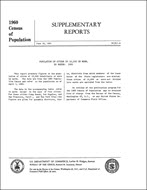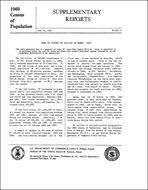
An official website of the United States government
Here’s how you know
Official websites use .gov
A .gov website belongs to an official government organization in the United States.
Secure .gov websites use HTTPS
A lock (
) or https:// means you’ve safely connected to the .gov website. Share sensitive information only on official, secure websites.
-
//
- Census.gov /
- Library /
- Publications /
- 1960 Census: Population, Population of Congressional Districts
1960 Census of Population: Supplementary Reports: Population of Congressional Districts for 88th Congress, April 1, 1960
1960 Census of Population: Supplementary Reports: Population of Congressional Districts for 88th Congress, April 1, 1960
The population figures for the congressional districts for the next (88th) Congress, as defined on July 1, 1962, are presented in this report. The House of Representatives is scheduled to revert from 437 to 435 members for the 88th Congress, with 22 Representatives to be elected at large and 413 to represent specific congressional districts within States.
Representatives at Large are elected in the five States which are entitled to only one Representative--Alaska, Delaware, Nevada, Vermont, and Wyoming. All eight of the Representatives from Alabama are to be elected at large. Five States which gained a seat--Hawaii, Maryland, Michigan, Ohio, and Texas--will elect the additional member at large. Connecticut again has one Representative at Large, and New Mexico continues to elect both of its Representatives at Large. In the 87th Congress, there are 11 Representatives elected at large, including two from North Dakota. That State, however, has now been divided into two districts for the forthcoming election. (See table 1.)
Excluding Maryland, 20 States have redistricted in accordance with the apportionment based on the results of the 1960 Census. The Maryland legislature redistricted the State; however, the act is subject to referendum at the November election. Consequently, Representatives will be elected from the seven current districts, and the member gained by the State will be elected at large. Of the eight States other than Maryland which gained seats, four redistricted and four added a Representative at Large. Of the 16 States which lost one or more seats, all except Alabama have redistricted. The twentieth State to redistrict, North Dakota, changed from election at large to election from districts.
The PDF to the right contains the 5-page report.
A Note on Language
Census statistics date back to 1790 and reflect the growth and change of the United States. Past census reports contain some terms that today’s readers may consider obsolete and inappropriate. As part of our goal to be open and transparent with the public, we are improving access to all Census Bureau original publications and statistics, which serve as a guide to the nation's history.
Share
Related Information
Some content on this site is available in several different electronic formats. Some of the files may require a plug-in or additional software to view.
 Yes
Yes
 No
NoComments or suggestions?


Top


